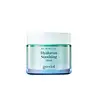What's inside
What's inside
 Key Ingredients
Key Ingredients

No key ingredients
 Benefits
Benefits

 Concerns
Concerns

No concerns
 Ingredients Side-by-side
Ingredients Side-by-side

Water
Skin ConditioningGlycerin
HumectantVinyldimethicone
Butylene Glycol
HumectantCaprylyl Methicone
Skin ConditioningDipropylene Glycol
Humectant1,2-Hexanediol
Skin ConditioningPentylene Glycol
Skin ConditioningErythritol
HumectantXylitol
HumectantHouttuynia Cordata Extract
Skin ConditioningSaccharomyces Ferment Filtrate
HumectantSodium Hyaluronate
HumectantChamaecyparis Obtusa Oil
MaskingEucalyptus Globulus Leaf Oil
PerfumingHydrolyzed Hyaluronic Acid
HumectantHyaluronic Acid
HumectantCandida Bombicola/Glucose/Methyl Rapeseedate Ferment
AntimicrobialVitis Vinifera Seed Oil
EmollientCentella Asiatica Leaf Extract
Skin ConditioningChrysanthemum Zawadskii Extract
Skin ConditioningHelianthus Annuus Seed Oil
EmollientPortulaca Oleracea Extract
Skin ConditioningEthylhexyl Palmitate
EmollientAmmonium Acryloyldimethyltaurate/Vp Copolymer
Sorbitol
HumectantTromethamine
BufferingAcrylates/C10-30 Alkyl Acrylate Crosspolymer
Emulsion StabilisingCaprylic/Capric Triglyceride
MaskingEthylhexylglycerin
Skin ConditioningPanthenol
Skin ConditioningHydrogenated Lecithin
EmulsifyingSodium Phytate
Ceramide NP
Skin ConditioningBeta-Glucan
Skin ConditioningAlbatrellus Confluens Extract
HumectantEctoin
Skin ConditioningCellulose
AbsorbentPolyglutamic Acid
Skin ConditioningHyaluronic Acid/Polyisopropylacrylamide Copolymer
HumectantGlyceryl Caprylate
EmollientDimethylsilanol Hyaluronate
HumectantHydrolyzed Sodium Hyaluronate
Skin ConditioningPotassium Hyaluronate
Skin ConditioningTocopherol
AntioxidantHydroxypropyltrimonium Hyaluronate
Sodium Hyaluronate Crosspolymer
HumectantPropanediol
SolventSodium Hyaluronate Dimethylsilanol
HumectantSodium Acetylated Hyaluronate
HumectantPolyglyceryl-10 Isostearate
Skin ConditioningPolyglyceryl-10 Oleate
Skin ConditioningStearic Acid
CleansingCeramide Ns
Skin ConditioningCholesterol
EmollientPhytosphingosine
Skin ConditioningCeramide AP
Skin ConditioningCeramide As
Skin ConditioningCeramide EOP
Skin ConditioningCarbomer
Emulsion StabilisingCetearyl Alcohol
EmollientWater, Glycerin, Vinyldimethicone, Butylene Glycol, Caprylyl Methicone, Dipropylene Glycol, 1,2-Hexanediol, Pentylene Glycol, Erythritol, Xylitol, Houttuynia Cordata Extract, Saccharomyces Ferment Filtrate, Sodium Hyaluronate, Chamaecyparis Obtusa Oil, Eucalyptus Globulus Leaf Oil, Hydrolyzed Hyaluronic Acid, Hyaluronic Acid, Candida Bombicola/Glucose/Methyl Rapeseedate Ferment, Vitis Vinifera Seed Oil, Centella Asiatica Leaf Extract, Chrysanthemum Zawadskii Extract, Helianthus Annuus Seed Oil, Portulaca Oleracea Extract, Ethylhexyl Palmitate, Ammonium Acryloyldimethyltaurate/Vp Copolymer, Sorbitol, Tromethamine, Acrylates/C10-30 Alkyl Acrylate Crosspolymer, Caprylic/Capric Triglyceride, Ethylhexylglycerin, Panthenol, Hydrogenated Lecithin, Sodium Phytate, Ceramide NP, Beta-Glucan, Albatrellus Confluens Extract, Ectoin, Cellulose, Polyglutamic Acid, Hyaluronic Acid/Polyisopropylacrylamide Copolymer, Glyceryl Caprylate, Dimethylsilanol Hyaluronate, Hydrolyzed Sodium Hyaluronate, Potassium Hyaluronate, Tocopherol, Hydroxypropyltrimonium Hyaluronate, Sodium Hyaluronate Crosspolymer, Propanediol, Sodium Hyaluronate Dimethylsilanol, Sodium Acetylated Hyaluronate, Polyglyceryl-10 Isostearate, Polyglyceryl-10 Oleate, Stearic Acid, Ceramide Ns, Cholesterol, Phytosphingosine, Ceramide AP, Ceramide As, Ceramide EOP, Carbomer, Cetearyl Alcohol
 Reviews
Reviews

Ingredients Explained
These ingredients are found in both products.
Ingredients higher up in an ingredient list are typically present in a larger amount.
1,2-Hexanediol is a synthetic liquid and another multi-functional powerhouse.
It is a:
- Humectant, drawing moisture into the skin
- Emollient, helping to soften skin
- Solvent, dispersing and stabilizing formulas
- Preservative booster, enhancing the antimicrobial activity of other preservatives
Butylene Glycol (or BG) is used within cosmetic products for a few different reasons:
Overall, Butylene Glycol is a safe and well-rounded ingredient that works well with other ingredients.
Though this ingredient works well with most skin types, some people with sensitive skin may experience a reaction such as allergic rashes, closed comedones, or itchiness.
Learn more about Butylene GlycolEthylhexylglycerin (we can't pronounce this either) is commonly used as a preservative and skin softener. It is derived from glyceryl.
You might see Ethylhexylglycerin often paired with other preservatives such as phenoxyethanol. Ethylhexylglycerin has been found to increase the effectiveness of these other preservatives.
Glycerin is already naturally found in your skin. It helps moisturize and protect your skin.
A study from 2016 found glycerin to be more effective as a humectant than AHAs and hyaluronic acid.
As a humectant, it helps the skin stay hydrated by pulling moisture to your skin. The low molecular weight of glycerin allows it to pull moisture into the deeper layers of your skin.
Hydrated skin improves your skin barrier; Your skin barrier helps protect against irritants and bacteria.
Glycerin has also been found to have antimicrobial and antiviral properties. Due to these properties, glycerin is often used in wound and burn treatments.
In cosmetics, glycerin is usually derived from plants such as soybean or palm. However, it can also be sourced from animals, such as tallow or animal fat.
This ingredient is organic, colorless, odorless, and non-toxic.
Glycerin is the name for this ingredient in American English. British English uses Glycerol/Glycerine.
Learn more about GlycerinWater. It's the most common cosmetic ingredient of all. You'll usually see it at the top of ingredient lists, meaning that it makes up the largest part of the product.
So why is it so popular? Water most often acts as a solvent - this means that it helps dissolve other ingredients into the formulation.
You'll also recognize water as that liquid we all need to stay alive. If you see this, drink a glass of water. Stay hydrated!
Learn more about Water